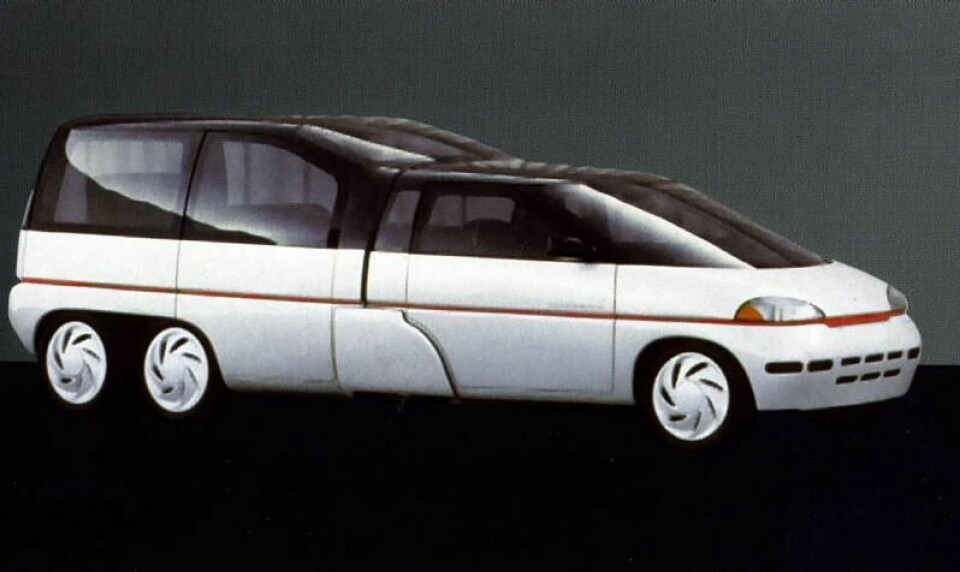
Plymouth Voyager III (1990)
An attempt to create the ultimate family car(s) by Plymouth
When we speak of hybrid vehicles, we usually speak of hybrid drivetrains. Hybrid vehicle packaging, however, is a more elusive and confusing concept, as we see in the current crossover/CUV/SUV market.
In 1989 Chrysler, looking to the future of the minivan, and family transportation, identified the optimal automobile combination that addressed the needs of many families: A small car for commuting and short errands, and also a large ,voluminous tourer for family hauling around town and long journeys.

Chrysler proposed a hybrid concept vehicle that would address both needs, The Plymouth Voyager III. The Voyager III was a two-part car – a small two-door runabout that could attach to a larger monospace passenger shell. As a small coupe, the front section was a wide, but short car, not three meters in length. Docked into the passenger shell it grew to executive car dimensions at just over five meters in length.

Conceptually, it might appear as if the Voyager III was the world’s smallest tractor-trailer rig, but the passenger shell did contain its own power supply. Each section, coupe and shell, had an on-board four cylinder engine that, when traveling as an ensemble, could be powered by all eight cylinders, electronically controlled to work in concert. Or one engine could power the Voyager in economy mode. An additional advantage of both engines running was the additional traction of four-wheel drive.

Looking at the two sections separately, there are eight wheels. But once linked together, the coupe’s rear wheels rise into covered recesses, thus enabling more efficient steering. Of course, from a design point of view, this created an enormously long and awkward wheelbase, which is further reflected in the overstretched proportions of the body itself.

Beyond the novelty of the packaging, the interior decor was fairly standard Chrysler fare for the time. The coupe was a bit wider than a typical small car, and three passengers sat in a single row of bucket seats. With the passenger shell attached, the seating expanded to eight, with the shell having a form of stadium seating, the rearmost seat raised above the rear engine. Echoing this step-up design, the glazed shell of the rear compartment also rose to allow for ease of entry and egress. This step-up design seemed to be an enlarged version of the roof of the Oldsmobile Vista Cruiser, with its “clerestory” upper windows that allowed for a great sense of openness, even for the rear passengers.

Walking around the Voyager III, it would be difficult to judge it as an automotive design – it is too awkward, too stretched. It is more like passenger bus, with its long wheelbase. The coupe section, as a small car, is pleasantly bland in its proportions and styling. But add on the passenger shell and the coupe looks almost comically small, totally out of proportion to the rest of the vehicle.

After its introduction at the Detroit and then Chicago shows, the Voyager III made the rounds at various car shows for a year and then dropped out of sight. Chrysler knew the car was too expensive to produce at that time and predicted that such a hybrid vehicle was a decade away at least.
Also, there was a fundamental flaw in the concept of the Voyager III. Yes, families need a compact commuter and an MPV-type vehicle. But they frequently need to use these vehicles at the same time. So having the cab/coupe section of the Voyager dart off to the city leaves the passenger section marooned at a time when kids need to be taken to school, and other errands need to be run. The flexibility of the Voyager 3 seems enticing, but is actually just as limiting or more so than having a Smart car for commuting and a traditional Chrysler minivan for family errands.

Interestingly, the two-stage, modular concept was revisited at a micro level by Rinspeed in 2011. The Smart Dock + Go concept augmented an electric Smart car with a booster “backpack” for additional range, and a mini storage unit for travel or for a delivery van. The Dock + Go seems a bit more successful a concept, maybe because of its quirky cuteness, and, well, Rinspeed cheekiness.

The concept of hybrid multistage vehicle might be further advanced in coming years, as a new generation of autonomous, shared vehicles might combine modules for different functions. At that time, the Plymouth Voyager III might be seen as a prescient vision. For now, we’ll take the Rinspeed…
Short Video of the Voyager 3:
https://www.youtube.com/watch?v=HUzLJkVsVJs
Cheeky / Fun video of the Rinspeed Dock + Go
https://www.youtube.com/watch?v=pUVATqfydEI




